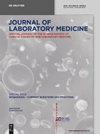Attention should be paid to false-positive results due to heterophilic antibodies interfering with Abbott high-sensitivity cardiac troponin I assay
IF 1.8
4区 医学
Q4 MEDICAL LABORATORY TECHNOLOGY
引用次数: 0
Abstract
Objectives In recent years, chemiluminescent microparticle immunoassay (CMIA) has been widely used for determination of high-sensitivity troponin I (hs-cTnI). However, a CMIA analysis is usually affected by the presence of some endogenous or exogenous substances. This case-report aims to unveil the essence of the reoccurrence of false-positive results due to heterophilic antibodies interference with Abbott high-sensitivity cardiac troponin I assay, although the assay method applied a chimeric antibody. Case presentation A 28-year-old female misdiagnosed with myocarditis due to falsely elevated hs-cTnI with an initial test result of 595.0 ng/L considered as critical value was reported. And the false critical value of hs-cTnI reoccurred five times after admission. The heterophilic blocking tube (HBT) procedure caused a decrease in troponin concentrations within the reference values, which suggests the presence of interference from heterophilic antibodies. Conclusions It requires a close and strong collaboration between clinicians and laboratorians to manage the similar case on the interference from heterophilic antibodies. To prevent false-positive results caused by interferences from being used in clinical practice, the clinicians are suggested to contact the laboratorians whenever the clinical picture, historical data and laboratory values are not conclusive.应注意因嗜异性抗体干扰阿博特高灵敏度心肌肌钙蛋白 I 检测而导致的假阳性结果
目的 近年来,化学发光微粒子免疫分析法(CMIA)被广泛用于测定高敏肌钙蛋白 I(hs-cTnI)。然而,CMIA 分析通常会受到一些内源性或外源性物质的影响。本病例报告旨在揭示由于嗜异性抗体干扰雅培高灵敏度心肌肌钙蛋白 I 检测而再次出现假阳性结果的本质,尽管检测方法采用的是嵌合抗体。病例介绍 据报道,一名 28 岁女性因 hs-cTnI 假性升高而被误诊为心肌炎,初始检测结果为 595.0 ng/L,被认为是临界值。入院后,hs-cTnI 的假临界值再次出现了五次。嗜异性阻断管(HBT)程序导致肌钙蛋白浓度下降至参考值范围内,这表明存在嗜异性抗体的干扰。结论 临床医生和实验室人员需要紧密合作,才能处理好嗜异性抗体干扰的类似病例。为防止干扰导致的假阳性结果被用于临床实践,建议临床医生在临床表现、历史数据和实验室值无法得出结论时与实验室联系。
本文章由计算机程序翻译,如有差异,请以英文原文为准。
求助全文
约1分钟内获得全文
求助全文
来源期刊

Journal of Laboratory Medicine
Mathematics-Discrete Mathematics and Combinatorics
CiteScore
2.50
自引率
0.00%
发文量
39
审稿时长
10 weeks
期刊介绍:
The Journal of Laboratory Medicine (JLM) is a bi-monthly published journal that reports on the latest developments in laboratory medicine. Particular focus is placed on the diagnostic aspects of the clinical laboratory, although technical, regulatory, and educational topics are equally covered. The Journal specializes in the publication of high-standard, competent and timely review articles on clinical, methodological and pathogenic aspects of modern laboratory diagnostics. These reviews are critically reviewed by expert reviewers and JLM’s Associate Editors who are specialists in the various subdisciplines of laboratory medicine. In addition, JLM publishes original research articles, case reports, point/counterpoint articles and letters to the editor, all of which are peer reviewed by at least two experts in the field.
 求助内容:
求助内容: 应助结果提醒方式:
应助结果提醒方式:


